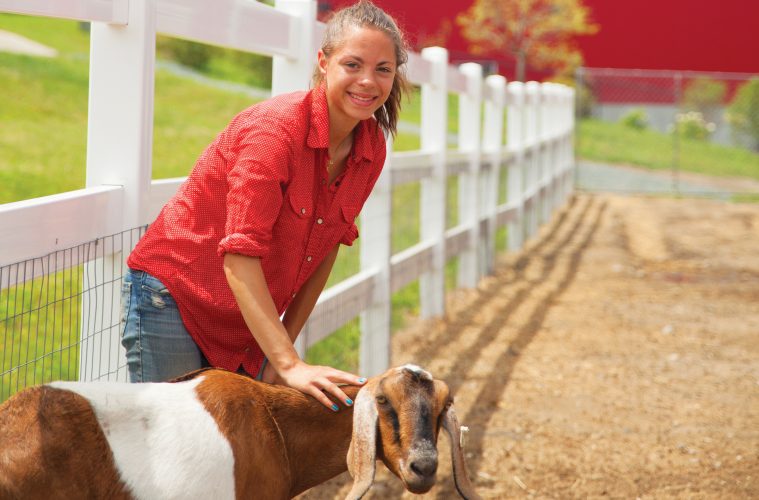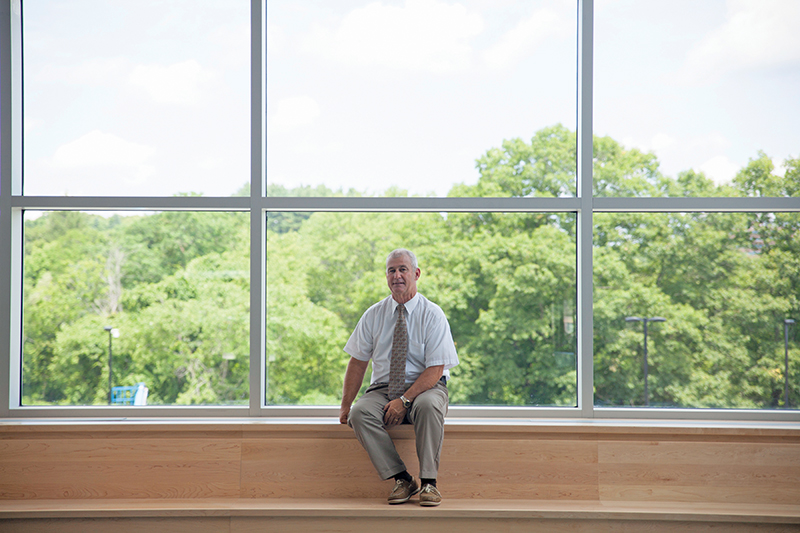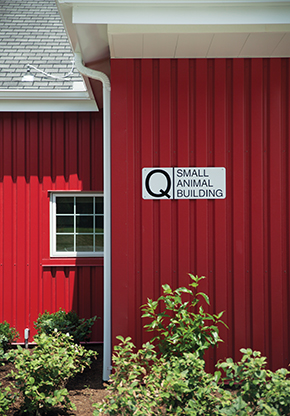POP QUIZ: There’s a new high school on the North Shore. Would you send your kid there?
(Trick question. You don’t yet have enough information to answer.)
It’s a public school located on the border of Middleton and Danvers, formed by the merger of two high schools that both graduate more than 97 percent of their students. One of the schools outperforms state averages on standardized tests by every measure—more than doubling the statewide rate of kids scoring “advanced” on the 10th-grade science exam—and it sends three-quarters of its students on to higher education. The other sends half of its kids to a two-or four-year college and performs more or less in line with state testing averages— even though 30 percent of the school’s students have disabilities.
Still stumped? Maybe this will help. Students spend three days at a time learning in traditional academic classes, and then spend three days learning practical, hands-on skills in content areas like animal science and information technology. Also, the school is located in a gleaming new $135 million building, complete with its own beauty salon, restaurant, and bakery.
Oh, one more thing: It’s a “voc” school. Have you changed your answer from yes to no? Celia Gelpey’s father almost did. “I was adamant about going, and my dad said, ‘Well, they don’t have the best reputation,’” recalls Gelpey, a red-haired 15-year-old sophomore at the brand-new Essex North Shore Agricultural & Technical High School. (The school is the result of a merger between Essex Agricultural and Technical High School, North Shore Technical High School, and some of Peabody’s career-focused programs.) “Once he talked to the academic teachers and realized what technical schools had to offer, as opposed to when he was in high school thirty-odd years ago, he realized it would be a better option.”
That term, “voc” (short for “vocational”), is a bit of a relic left over from, as Gelpey puts it, “thirty-odd” years ago or more. For people of a certain age, the word brings to mind dirty, disorganized shop classes where kids who “couldn’t learn” were warehoused until graduation, given hammers and wrenches in place of the textbooks they struggled to read. “When I was in high school, that was where the ‘dumb’ kids went,” says Marcia Sweeney, who is in her seventies and sits on the new district’s school committee. “They couldn’t cut it in a classroom, they didn’t get very good marks, and they were sent to the trade schools.”
|
These days, the word “vocational” has been mostly phased out, replaced by the more buttoned-up adjective “technical.” But the changes go beyond semantics.
The introduction of the Massachusetts Comprehensive Assessment System (MCAS) in the 1990s ensured that students at technical schools would be assessed on the same academic material as students at other high schools, holding the technical schools accountable for teaching that content instead of ignoring it and concentrating only on job training. Also, statewide learning frameworks for the technical content areas mean that schools are now held to higher standards for their vocational teaching, too. If a student studies carpentry, for example, he or she is now expected to graduate having mastered a certain standardized skill set.
At the same time, advances have been made in educators’ understandings about learning disabilities. Language about students who “can’t learn” has been replaced by talk of “meeting the needs of students with different learning styles.” “Ten to fifteen-plus years ago, you were a ‘vokie,’” says Dan O’Connell, superintendent of the new technical school. “You were a discipline prob- lem, you were an attendance problem. Everything was ‘you can’t.’ Those days are gone.” The only problem, O’Connell says, is that perception hasn’t fully caught up with reality.
“It’s more the parents that we have to convince than the students,” says Carol Sullivan, vocational director at the school. Any lingering doubts haven’t seemed to hurt enrollment, though. The new school was necessary in part because of overcrowding at the former Essex and North Shore schools, with both turning students away each year. “It used to be, we put a mirror under their nose,” Sullivan jokes. “If they were breathing, we let them in.”
|
Students at the school can still specialize in blue-collar (and decent-paying) trades like carpentry, electrical work, masonry, and auto repair. But they can also choose to study in fields like veterinary technology, environmental technology, and graphic design. Gelpey is specializing in biotechnology, one of four new areas being offered after the merger, along with dental assisting, plumbing, heating, and ventilation, and air conditioning and refrigeration. The inclusion of biotechnology, in particular, feels emblematic of the shift that’s occurred in technical education in Massachusetts over the past two decades. Students will gain lab experience growing cell cultures, preparing solutions, and transferring precise volumes of liquid with pipettes, all in preparation for careers in areas like academic and clinical research, forensics, and biotech manufacturing. It’s hardly the stereotypical image of “voc” school.
Arlyssa LaPorte, the school’s biotechnology teacher, says that career-specific training is needed now more than ever, and notes that biotech is a booming field in the state. “I think too many people are going to college without any sort of direction about what they want to do,” she says. “The biotech industry in Massachusetts has just exploded. I’m getting calls all the time from recruiters. If the skill set is there, there’s going to be enormous job potential for students.”
Gelpey says she will likely attend college, possibly getting a lab job to help fund her education. Even if she doesn’t end up pursuing in a career in biotechnology, she says, she’ll be able to use what she learns in other scientific fields. Laura Pham, another 15-year-old sophomore studying biotechnology, says she’ll “definitely” continue with her education after high school, with the goal of one day attending medical school or pursuing a Ph.D.
None of this is to say that there’s anything wrong with the blue-collar trades. The school opens this fall with 1,137 students and will grow to 1,440 students over four years, with enrollment spread evenly across four academies: animal and plant sciences, technology and services, life and natural sciences, and construction technology. Sixty slots will be reserved for students studying plumbing, the same number as biotechnology. And, as anyone whose basement has flooded over a holiday weekend can attest, the future plumbers might very well end up out-earning the biotechnicians. In fact, they may even attend college together.
“A few years back, we had an outstand- ing masonry student who started his own weekend business during his junior year,” recalls Sweeney, the school committee member. “When he graduated, I asked him, ‘Does the business expand now?’ And he said, ‘No, I’m going to college. I know how to build a wall and a fireplace, but I don’t know how to run a business, so I’m going to school to learn that.’”
The students who do go on to college often use the skills they’ve learned in high school to make money on the side. “They’re not working at McDonald’s part-time to pay their way through college,” Sweeney says. “They’re making good money through their craft.” agtech.org


 Superintendent Dan O’Connell
Superintendent Dan O’Connell A mix of classroom time and hands on learning will be the focus at the new agricultural and technical school
A mix of classroom time and hands on learning will be the focus at the new agricultural and technical school